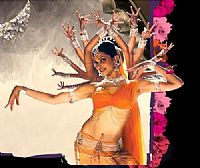 Days od Indian culture in POU Porec, Istra (Istria). Darbari Kathak - 19:00 Theatre POU Porec.
Days od Indian culture in POU Porec, Istra (Istria). Darbari Kathak - 19:00 Theatre POU Porec.
Entry 25 kn.
Kathak is the classical dance style of North India. The word Kathak is derived from katha , meaning "a story", and hence the word Kathak means a storyteller who recounted mythological tales in the temples and danced them in a state of ecstasy. Having its origin in the sacred text known as the Natya Shastra , set to be divinely inspired through the sage Bharata, it has become one of the most comprehensive and expressive languages of movement in the world.
With the advent of the Mogul rule in India (11th-18th centuries), it was transformed from a temple dance to court dance and became a brilliant entertainment. It was recognized in its innovative aspect by the Mogul emperors, especially the poet king Wajid Ali Shah who rescued it from oblivion, lent it dignity and founded the famed Lucknow Garana.
This dance form depicts "life" and is based on the philosophy of the trinity - creation (Brahma), preservation (Vishnu), and destruction (Mahesh). Its poses are seldom static and it has a continuous flow of movements very near to life. Equal stress is laid on intricate footwork and beauty of expression. It is two-dimensional in character; it conceives the space basically in straight lines and does not put emphasis on giving a three-dimensional effect. The human form is conceived as a straight line and there are very few deviations from the vertical median.
Kathak can be divided into nritta and abhinayaon the one hand and tandava and lasya on the other. Nritta and abhinaya are applicable to the movements in the dance style. Tandava and lasya have to do with the type of numerics which are played on the tabla or executed by the feet.
Kathak is unique for its Footworks and Circles. It is for both male and female.